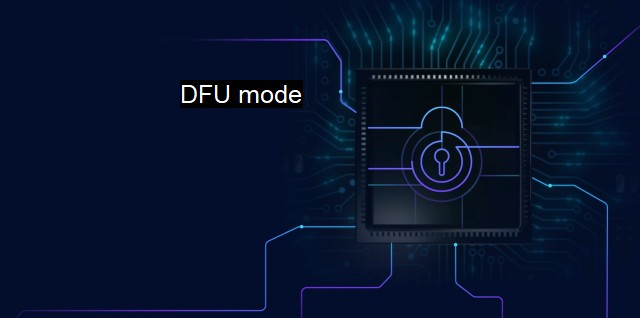What is DFU mode?
The Risks Associated with DFU (Device Firmware Update) Mode on Apple iPhones and Their Impact on Cybersecurity
DFU Mode, or Device Firmware Upgrade mode, plays a crucial role in the context of cybersecurity and antivirus protection, notably in devices such as iPhone, iPad and iPod. This concept is particularly important in terms of updating firmware, restoring iOS and troubleshooting different types of issues. It represents a state in which a device can interface with iTunes but does not load the iPhone or iPad operating system or boot loader on startup. This, therefore, allows software-related issues and potential malware or viruses to be resolved, analyzed or prevented.Primarily, DFU Mode is utilized to upgrade or downgrade the firmware and iOS, reset the device to factory settings, unlock the device carrier, or jailbreak the device. But from the cybersecurity viewpoint, DFU Mode is much more than that. It is a preventative measure that helps restructuring network infrastructure and the data contained in a device at a microscopic level. If a troublesome piece of code were to infiltrate the system, placing the device into DFU mode would allow for an environment in which it could be addressed without further harming the device or compromising important information.
Considering the increasing threat landscape of our technological reliance, malware and viruses exhibit a growing concern. Because these viruses can breach our devices using a plethora of techniques, refraining from necessary cybersecurity measures, such as the application of DFU mode, may make our data more susceptible to attacks. Emphasizing certain antivirus softwares could become ineffective once an embedded piece of malware administers access to the device's critical aspect. Firmware level threats intertwine within the device in such an intricate manner that only a complete system reboot with a more fundamental approach like the DFU mode can successfully address the issue.
Owing to this functionality, DFU mode becomes an integral element while discoursing about cybersecurity and antivirus measures. It allows for direct alterations in the firmware, coursing below the operating system's foundational level, granting us the provision of eliminating potential threats that may conceal themselves beneath the superficial layers of an operating system. This gives DFU a significant edge over antivirus programs that operate at an operational level, falling short when confronted with sophisticated firmware-level threats.
DFU Mode contributes significantly to the overall security posture of a user's device. It allows the fortification of digital ecosystems and safeguards valuable data against powerful encrypted malware and potentially devastating zero-day threats which maybe have exploited potential vulnerabilities prior to cybersecurity defenses recognition. By entering DFU mode, a user can create a barrier of insulation around their device, safeguarding it against unnecessary threats and possible harmful activity.
Thus, while DFU Mode may seem like a primarily technical feature, its relevance to cybersecurity and antivirus initiatives cannot be overstated. It is a powerful tool, allowing for continued protection even in threatening circumstances. While antivirus programs share an indispensable role in any sound cybersecurity strategy, acknowledging methodologies such as DFU mode adds another layer to our technological defenses. As such, it can help minimize damage, isolate threats, thoroughly analyze potential malware and hopefully prevent future infiltration. In today's era, ensuring a comprehensive cyber defense system calls for facets like the Device Firmware Upgrade mode, balancing attention along with active operational level initiatives.

DFU mode FAQs
What is DFU mode and how does it relate to cybersecurity and antivirus?
DFU mode, which stands for Device Firmware Update mode, is a state that a mobile device can enter to allow for firmware updates or repairs. In terms of cybersecurity and antivirus, DFU mode can be used to bypass security restrictions or remove malware that may be interfering with normal device operation.How do I enter DFU mode on my device?
The process to enter DFU mode varies depending on the specific device and operating system. Typically, it involves connecting the device to a computer and using specific key combinations or software to put the device into DFU mode. It's important to follow instructions carefully, as entering DFU mode improperly can potentially damage the device.Is DFU mode safe to use for cybersecurity and antivirus purposes?
DFU mode can be a useful tool for cybersecurity and antivirus purposes, but it should be used with caution. If used improperly or without proper knowledge, it can potentially cause damage to the device or leave it vulnerable to security threats. It's recommended to seek professional assistance or thoroughly research DFU mode before attempting to use it for security purposes.Can DFU mode be used to unlock or jailbreak a device?
Yes, DFU mode can be used for device unlocking or jailbreaking, which refers to removing software restrictions imposed by the device manufacturer or operating system. However, unlocking or jailbreaking a device can leave it vulnerable to security threats and may void the device's warranty or violate user agreements. It's important to consider the potential risks before attempting to unlock or jailbreak a device.| | A | | | B | | | C | | | D | | | E | | | F | | | G | | | H | | | I | | | J | | | K | | | L | | | M | |
| | N | | | O | | | P | | | Q | | | R | | | S | | | T | | | U | | | V | | | W | | | X | | | Y | | | Z | |
| | 1 | | | 2 | | | 3 | | | 4 | | | 7 | | | 8 | | |||||||